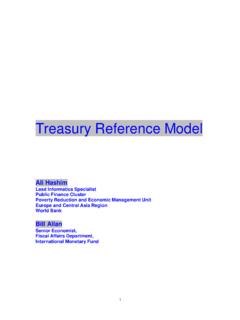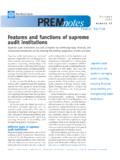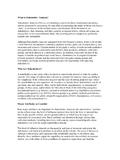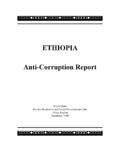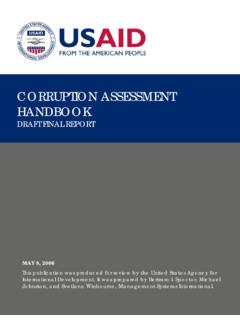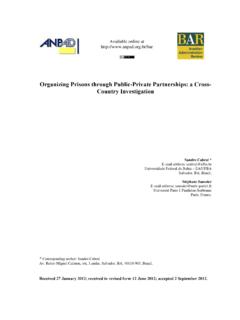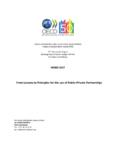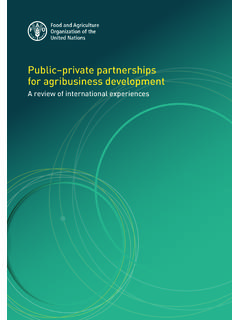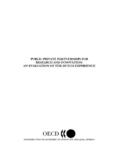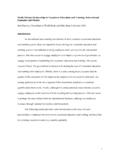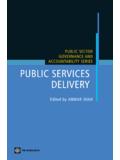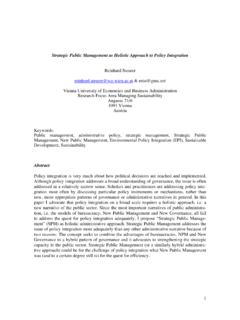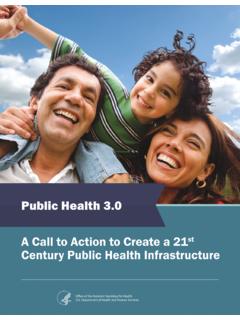Transcription of REFORMING PUBLIC INSTITUTIONS AND …
1 REFORMING PUBLIC INSTITUTIONS AND strengthening governance A World Bank Strategy PUBLIC Sector Board Poverty Reduction and Economic Management Network September, 2000 ii ii Foreward The critical importance of well-performing PUBLIC INSTITUTIONS and good governance for development and poverty reduction has come to the forefront in the 1990s. Just as it was increasingly recognized in the 1980s that individual investment projects are less likely to succeed in a distorted policy environment, so it has become obvious in the 1990s that neither good policies nor good investments are likely to emerge and be sustainable in an environment with dysfunctional INSTITUTIONS and poor governance .
2 At the same time, it is also clear that REFORMING PUBLIC INSTITUTIONS is a complex and difficult task, both technically and politically. Unlike first generation reforms such as exchange rate unification and trade liberalization, which could often be undertaken through the actions by a relatively small number of policy makers and PUBLIC managers, institutional reform typically involves fundamental changes in the rules of the game for a large number of civil servants and private citizens. Such changes are likely to require long-term high-level commitment, in-depth knowledge, and extensive support and assistance. The World Bank is deeply committed to helping its client countries build well-functioning and accountable governments, and the amount of lending and nonlending services it offers for core PUBLIC sector reform have expanded rapidly in the past 4 years.
3 This strategy for REFORMING PUBLIC INSTITUTIONS and strengthening governance is part of a broader World Bank s effort to delineate sector and thematic strategies to guide our work. While it is intended primarily as a guide for our own work, we hope that the lessons of experience and the goals and approaches for the future that it delineates are of broader relevance to the development community. Kemal Dervis Vice-President Poverty Reduction and Economic Management Network iii iii Acknowledgements This strategy paper was prepared by the PUBLIC Sector Board, Poverty Reduction and Economic Management (PREM) Network, under the direction of Cheryl Gray (Director, PUBLIC Sector).
4 Current and/or past members of the Board who contributed to the report and were primarily responsible for the individual VPU strategies in Part II include Shanta Devarajan (Development Research Group), Ali Khadr (Middle East and North Africa), Daniel Kaufmann (World Bank Institute), Brian Levy (Africa), Helga Muller and Sanjay Pradhan (Europe and Central Asia), Barbara Nunberg (East Asia/ Pacific), Shekhar Shah (South Asia), and Geoffrey Shepherd (Latin America/Caribbean). Brian Levy, Melissa Thomas and Tripti Thomas had major roles in drafting and/or editing parts of the document.
5 Anna Hansson and Tripti Thomas were primarily responsible for the data on the PUBLIC sector portfolio and the inventory of governance activities, Nick Manning contributed to the annex on analytic tools, and Steve Knack had a major role in updating the annexes on governance indicators and on the links between poverty and governance . Vinaya Swaroop contributed to the annex on Bank-Fund relations. In addition, many useful contributions were received from Bank staff and external advisors, including Paul Bermingham, Colin Bruce, Monali Chowdhurie-Aziz, Mamadou Dia, Isabelle Bleas, John Heilbrunn, Malcolm Holmes, Arturo Israel, Phil Keefer, Jennie Litvack, Yasuhiko Matsuda; Robert Picciotto, Anwar Shah, Allen Schick, Miguel Schloss, Graham Scott, Rick Stapenhurst, Mike Stevens, Eric Swanson, Vinaya Swaroop, John Todd, and Ulrich Zachau.
6 We also benefited from extensive comments from members of the Executive Board during discussions with the Committee on Development Effectiveness (CODE) in December 1999 and January 2000 and discussions with the full Board in July 2000, and from comments received from numerous external partners during consultations (most between January and May 2000) in Abidjan, Copenhagen, Harare, London, Maastricht, Manila, New York, Paris, Stockholm, Warsaw, and Washington. We are grateful to the many other people inside and outside the Bank who also provided valuable comments on previous drafts. The strategy and extensive related and supporting material on various aspects of PUBLIC sector reform and governance are available through the World Bank s website at Extensive governance -related information is also available through WBI s website at i i List of Acronyms ACBF Africa Capacity Building Foundation ADB Asian Development Bank AFDB Africa Development Bank AFR Africa Regional Vice-Presidency AMF/ Arab Monetary Fund/Arab Fund for AFSED Social and Economic Development APL/C Adaptable Program Loan/Credit ASA Association for Social
7 Advancement ASEM Asia-Europe Meeting AU Antibribery Undertaking BRAC Bangladesh Rural Advancement Committee CAPAM Commonwealth Association for PUBLIC Management CAS Country Assistance Strategy CCCE Caisse Centrale de Coop ration Economique CDF Comprehensive Development Framework CEE Central and Eastern Europe CEM Country Economic Memorandum CFAA Country Financial Accountability Assessment CIDA Canadian International Development Agency CIS Commonwealth of Independent States CLAD Centro Latinoamericano de Administracion para el DeSarrollo CMU Country Management Unit CPAR Country Procurement Assessment Report CPI Corruption Perception Index CPIA Country Performance and Institutional Assessment CSR Civil Service Reform DAC Development Assistance Committee DANIDA Danish International Assistance Agency DEC Development Economics Vice-Presidency DECDG Development Data Group DRG Development Research Group DFID Department for International Development, DL Distance Learning EA5 East Asia 5 (Indonesia, Korea, Malaysia, Philippines, Thailand)
8 EAP East Asia and Pacific Regional Vice-Presidency EASPR Poverty Reduction and Economic Management Sector Unit, EAP EBRD European Bank for Reconstruction and Development ECA Europe and Central Asia Regional Vice Presidency ECSPE Poverty Reduction and Economic Management Sector Unit, ECA EDI Economic Development Institute (now WBI) ERF Economic Research Forum ESSD Environmentally and Socially Sustainable Development Network ESW Economic and Sector Work EU European Union EUROMED Euro-Mediterranean Partnership FIAS Foreign Investment Advisory Service FPSI Finance, Private Sector and Infrastructure Network GCA Global Coalition for Africa GDP Gross Domestic Product GNP Gross National Product GR Institutional and governance Review GTZ German Association for Technical Cooperation IBRD International Bank for Reconstruction and Development HD Human Development Network HNP Health Nutrition and Population IBTA Institution Building/Technical Assistance ICITAP International Criminal Investigation Training Assistance Program ICRG International Consulting Resources Group IDA International Development Association IDB Inter-American Development Bank IDF Institutional Development Facility IGR Institutional
9 And governance Review INFID International NGO Forum on Indonesian Development IFI International Financial INSTITUTIONS IMF International Monetary Fund INDECOPI Instituto Nacional de Defensa de la Competencia y de la Protecci n de la Propiedad Intelectual, Peruvian Competition Agency INTOSAI International Organization of Supreme Audit INSTITUTIONS IRIS Center for Institutional Reform and the Informal Sector, U. Maryland IRMT International Records Management Trust JICA Japan International Cooperation Agency KMS Knowledge Management System LAC/LCR Latin America and Caribbean Regional Vice-Presidency LCSHD Human Development Sector Unit, LCR ii iiLCSPR Poverty Reduction and Economic Management Sector Unit, LCR LEG Legal Vice-Presidency LEGLR Legal and Judicial Reform Unit LIL Learning and Innovations Loan LLC Learning and Leadership Center (WBI)
10 LTPS Long-Term Perspectives Study for Sub-Saharan Africa MDB Multi-lateral Development Bank MDF Mediterranean Development Forum MENA Middle East and North Africa Regional Vice-Presidency MIS Management Information Systems MOJ Ministry of Justice MTEF Medium Term Expenditure Framework NGO Non-Governmental Organization NMAD National-Municipal Accountability Diagnostics NORAD Norwegian Agency for Development Cooperation NPM New PUBLIC Management O&M Operations & Maintenance OAS Organization of American States OCS Operational Core Services Network OECD Organization for Economic Co-operation and Development OED Operations Evaluation Department ONEP Oficina Nacional de Etica Publica OP Operational Policy OPE Office of Professional Ethics OSCE Organization for Security and Co-operation in Europe OSG Operations Support Group OVP Operational Vice President PACT Partnership for Capacity Building in Africa PER PUBLIC Expenditure Review PHARE Poland and Hungary.
